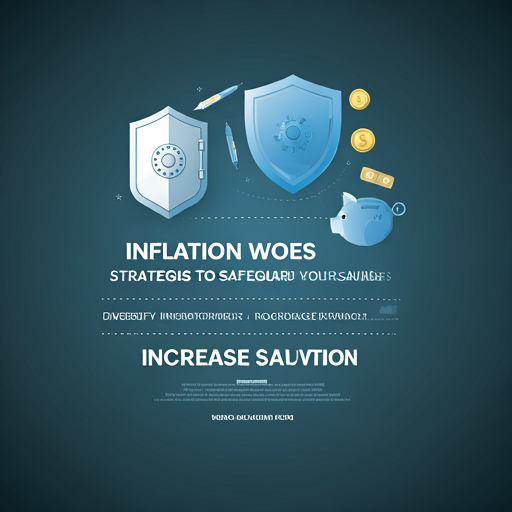Introduction to Inflation and Its Impact on Savings
Understanding Inflation: Causes and Effects
Inflation occurs when the general price level of goods and services rises, diminishing purchasing power. This phenomenon can significantly impact savings, as individuals find their money buys less over time. He may notice that his savings do not stretch as far as they once did. This realization can be disheartening.
Moreover, inflation can erode the value of fixed-income investments, leading to lower returns. He might feel concerned about the long-term viability of his savings strategy. Understanding these dynamics is crucial for effective financial planning. Knowledge is power in this context.
The Historical Context of Inflwtion and Savings
Historically, inflation has fluctuated due to various economic factors, impacting savings strategies. For instance, during the 1970s, high inflation rates led to negative real interest rates. This situation discouraged saving and encouraged spending. Many individuals felt the pressure to invest in assets that could outpace inflation.
Key periods of inflation include:
Understanding these trends is essential for effective financial planning. Knowledge empowers better decision-making.
The Role of Cryptocurrency in Inflationary Times
How Cryptocurrencies Can Hedge Against Inflation
Cryptocurrencies offer a unique hedge against inflation due to their decentralized nature and limited supply. For example, Bitcoin has a capped supply of 21 million coins, which contrasts with fiat currencies that can be printed without limit. This scarcity can preserve value over time. Many investors view cryptocurrencies as a store of value.
Key advantages include:
These features can mitigate inflationary pressures. Understanding these dynamics is crucial for informed investing. Knowledge is essential in this volatile market.
Comparing Cryptocurrencies to Traditional Assets
Cryptocurrencies and traditional assets differ significantly in their characteristics and behaviors. He may find that cryptocurrencies offer higher volatility compared to stocks or bonds. This volatility can present both risks and opportunities. Many investors are drawn to potential high returns.
Key differences include:
These factors influence investment strategies. Understanding these distinctions is vital for effective portfolio management. Knowledge leads to better decisions.
Diversifying Your Investment Portfolio
The Importance of Asset Diversification
Asset diversification is crucial for mitigating risk in an investment portfolio. By spreading investments across various asset classes, he can reduce exposure to any single economic event. This strategy enhances the potential for stable returns. Many investors prioritize this approach.
Key benefits include:
Understanding these principles is essential for effective investing. Knowledge is power in finance.
Incorporating Cryptocurrencies into Your Portfolio
Incorporating cryptocurrencies into an investment portfolio can enhance diversification. By allocating a portion of assets to digital currencies, he can potentially increase overall returns. This approach allows for exposure to a rapidly growing market. Many investors are intrigued by this opportunity.
Key considerations include:
These factors are essential for informed decisions. Knowledge is vital in this evolving landscape.
Stablecoins: A Safe Haven in Volatile Markets
What Are Stablecoins and How Do They Work?
Stablecoins are digital currencies designed to maintain a stable value, typically pegged to fiat currencies like the US dollar. He may find that this stability makes them attractive during market volatility. By minimizing price fluctuations, stablecoins provide a safe haven for investors. Many individuals use them for trading and as a store of value.
Key features include:
These attributes enhance their reliability. Knowledge is essential for effective use.
Using Stablecoins to Preserve Value
Using stablecoins can effectively preserve value during economic uncertainty. He may choose to convert volatile assets into stablecoins to mitigate risk. This strategy allows for maintaining purchasing power without exiting the cryptocurrency market. Many investors appreciate this flexibility.
Key advantages include:
These factors make stablecoins a practical choice. Knowledge is crucial for informed decisions.
Strategies for Long-Term Wealth Preservation
Investing in Hard Assets: Gold, Real Estate, and More
Investing in hard assets like gold and real estate can provide a hedge against inflation. He may find that these assets typically retain value over time. This strategy can enhance long-term wealth preservation. Many investors prioritize tangible assets for stability.
Key considerations include:
These factors are essential for effective investing. Knowledge is power in asset management.
Utilizing Cryptocurrency Staking and Yield Farming
Utilizing cryptocurrency staking and yield farming can enhance returns on digital assets. He may earn passive income by locking up his cryptocurrencies in staking protocols. This strategy allows for participation in network security while generating rewards. Many investors find this appealing.
Key benefits include:
These factors contribute to effective wealth preservation. Knowledge is essential for maximizing gains.
Staying Informed: The Importance of Market Research
Tools and Resources for Cryptocurrency Research
Utilizing various tools and resources is essential for effective cryptocurrency research. He can access platforms like CoinMarketCap and CoinGecko for real-time data. These resources provide insights into market trends and price movements. Many investors rely on these tools for informed decisions.
Key resources include:
These tools enhance understanding of the market. Knowledge is crucial for successful investing.
Understanding Market Trends and Indicators
Understanding market trends and indicators is vital for making informed investment decisions. He should analyze price movements and trading volumes to gauge market sentiment. This analysis can reveal potential entry and exit points. Many investors rely on technical indicators for guidance.
Key indicators include:
These tools enhance strategic planning. Knowledge is essential for effective trading.
Conclusion: Taking Action Against Inflation
Creating a Personal Financial Plan
Creating a personal financial plan is essential for navigating inflation effectively. He should assess his current financial situation and set clear goals. This process involves budgeting, saving, and investing wisely. Many individuals benefit from a structured approach.
Key components include:
These elements enhance financial resilience. Knowledge is key to success.
Embracing Change: The Future of Money and Savings
Embracing change in financial systems is crucial for adapting to evolving economic landscapes. He must recognize the increasing role of digital currencies and decentralized finance. These innovations can offer new opportunities for savings and investment. Many investors are exploring these options.
Key trends include:
These advancements can reshape financial strategies. Knowledge is essential for future success.
